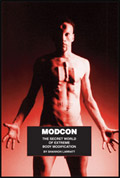(Is it bad business that I am more inclined to do interviews with highschool students than “real” journalists? Maybe I'm crazy, but I believe the future is built on the actions of the young, not what old people write about them.)
What, in your experience, is the main reason that people undergo the more extreme modifications? Is it for aesthetic purposes only or does the feeling of the procedure have to do with it? How often does the feeling drive the desire to get them?
I don’t believe there is a main reason. Definitely a lot of people are doing it simply because they like the way it looks (and I think that’s a good enough reason). Lots of others are doing it because they like the way it feels, either on a simple physical level, or on a more emotional or even spiritual level.
I know a surprising amount of people that have integrated their body modifications into their faith as well. To simplify how that works, if one believes that God created humans and the world, by exploring his creation (your body) and modifying it and exploring it and playing with it, you gain insight into your body and who you are physically. Many feel this is the only hands on way that we can really get a little hint at God’s “personality”, and find it deeply rewarding on a spiritual level.
But when it comes down to it, there are a million different reasons for a million different people. Most of them are good reasons I hope.
Is there professional training for people who perform the procedures (such as skin removal scarification or branding)?
There is no formal program available, and I’d be surprised if there is any time in the immediate future. There are professional organizations like the APP (Association of Professional Piercers) as well as private groups such as Health Educators, Fakir Musafar (the only one to offer branding education), and so on that offer excellent training in elements of piercing and other modifications, but they are not complete programs (and are not intended to be), and they really only cover the basics.
Artists working in this field tend to be either self educated through a combination of reading and experimentation, or apprenticed. The apprenticeship program has a long tradition in skills like this, going back to the guilds of the Middle Ages, and I feel that it can offer a better education than we could ever devise in a “school” type situation. A few parts of the US (Philadelphia for example) have actually codified this in their body modification laws, requiring a verifiable apprenticeship period with another reputable artist.
How would someone know if the person they were going to was trustworthy? Is that mainly by word of mouth? How would you find a person if you were interested in getting a modification?
BME is a good place to start of course, because you can read people’s stories about being worked on by different artists around the world, and look at pictures of their work. The FAQs and other educational documents like BME/Risks help to build up the base knowledge that everyone should have. As with all things, the best way to get good service is to be an informed consumer. So learn everything you can before you buy!
How legal are these procedures in the different states?
Tattooing and piercing are almost universally legal, although they have different restrictions from state to state. Scarification tends to be a little gray, but is generally legal as well. Stuff that borders on surgery like tongue splitting is probably illegal when it comes right down to it, but most jurisdictions allow it to continue as long as it stays under the public radar.
What is normally used for chemical scarification?
To be honest, chemical scarification is really rare and there isn’t really a standard — and I’d be surprised if that changes any time soon.
What is used for skin removal?
A scalpel, usually a standard #11, is used for the cutting and peeling, and small clamps like mosquito forceps are used to help pull off the skin. Sometimes a dermal punch is used in specialized cases where a clean circle has to be removed.
Do people tend to stick to one kind of modification repeatedly, or do they tend try many different kinds?
In the past it was pretty common for people to stick to just tattooing — in fact, when they first started to popularize, there was a bit of a schism between the tattoo community and other modifications like body piercing for a long time (even to the extent where facial piercing was banned from early tattoo conventions).
But these days it’s getting more and more rare to find someone who doesn’t have at least an interest in piercings and tattoos together, and, at least when it comes to the kind of people who read BME, there is a definite interest in a very wide range, including things that people might not generally consider like cosmetic surgery and body building. To put it simply, I think we’re figuring out that it’s OK to make our body into any form that makes us happy, and that it’s OK to use a myriad of different methods to achieve that.
Does one procedure tend to be favored by one sex?
Other than stuff that’s limited by anatomy (ie. genital piercing, etc.), no, I don’t think there’s a gender bias for most modifications.
Is it more common for one sex to do the more extreme modifications?
Male anatomy is very suited to “extreme” modifications, so there are probably more men doing that type of work. But if you mean things like heavy cuttings, unusual facial work, and other hardcore modifications, women are just as active as men are.
How often does a person get multiple procedures done after having one modification?
Almost always. It’s rare for people to stop at one. It’s not because it’s “addictive” or anything like that (although people do tend to use that word to explain it). It’s no more addictive than, say, good music. Do you listen to good music because you are a person with good taste, or because you’re addicted?
What is the average age range of the people who get the more extreme modifications, if there is one?
I don’t think there’s an average age. If you asked me that question five or six years ago, I’d have told you that people don’t usually get extreme modifications until they’re in their forties or so, but these days it’s very common for people to have really far out and heavy modifications by the time they are in their early twenties.
I worry about this a little because it’s a very heavy burden to carry if you’re not ready for it (the plainskins do treat modified people with some distrust and fear!), and I think sometimes people get in over their head.



Post a Comment